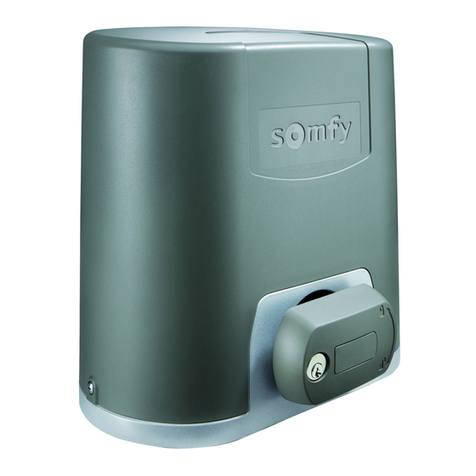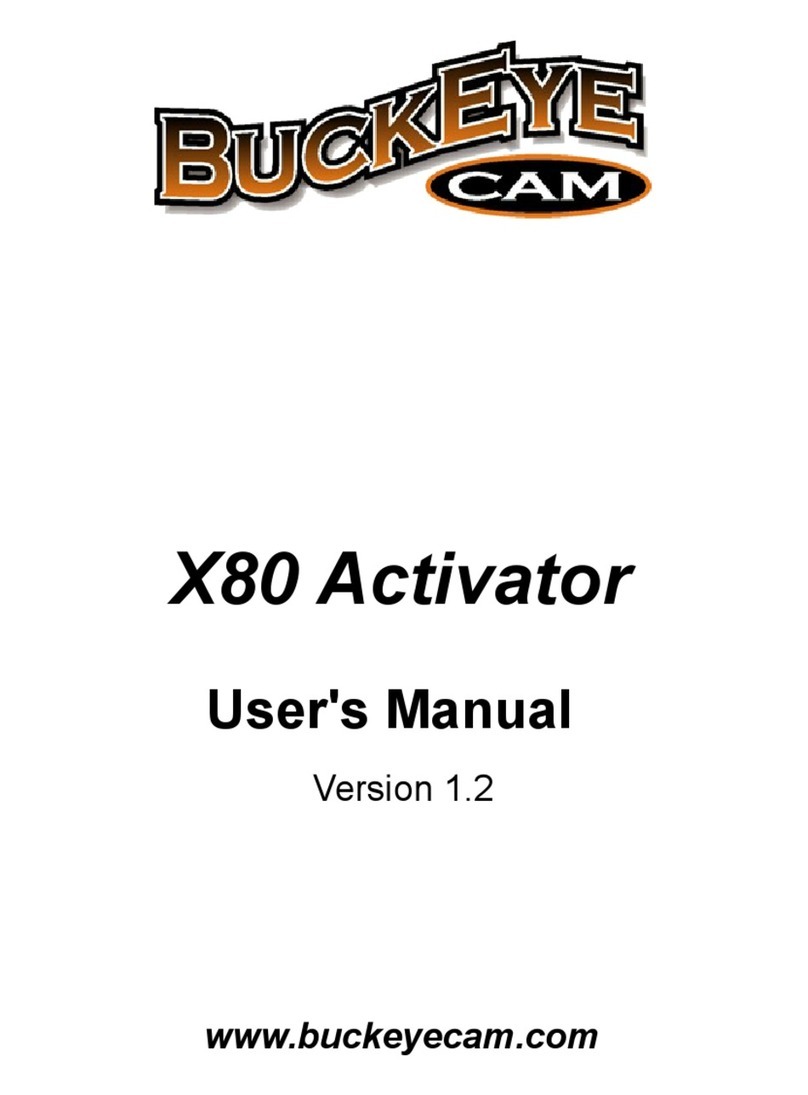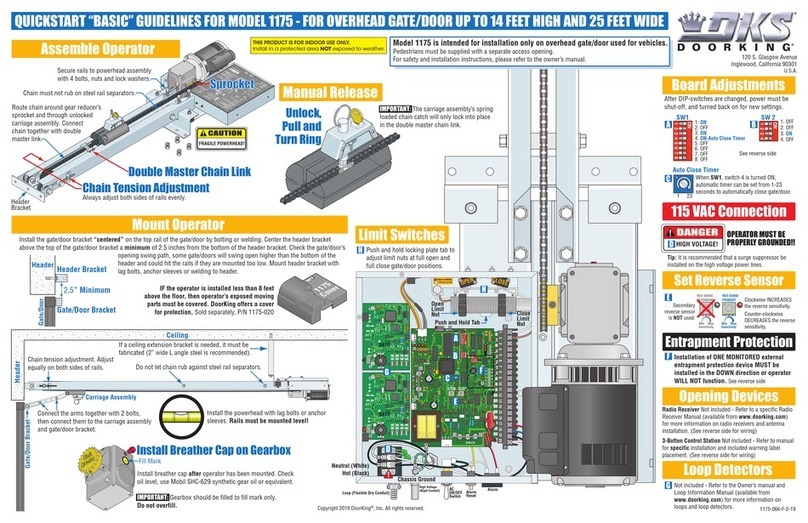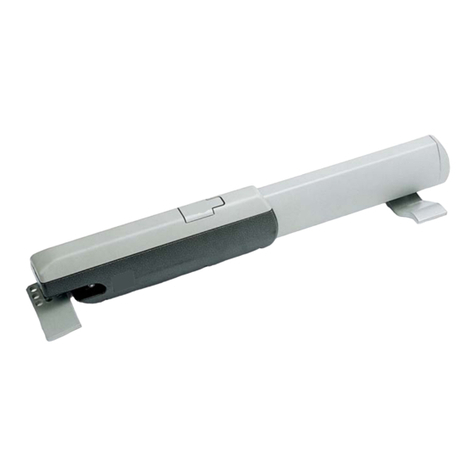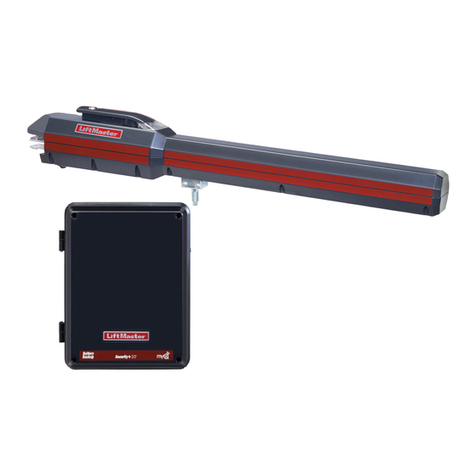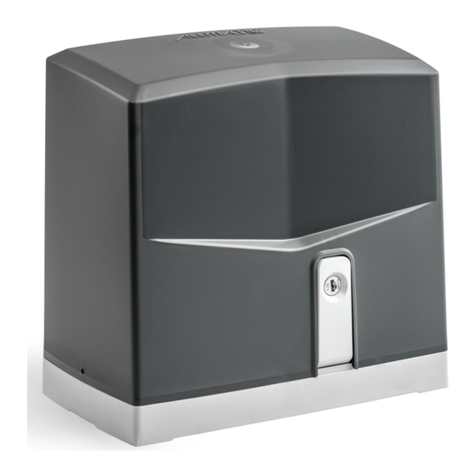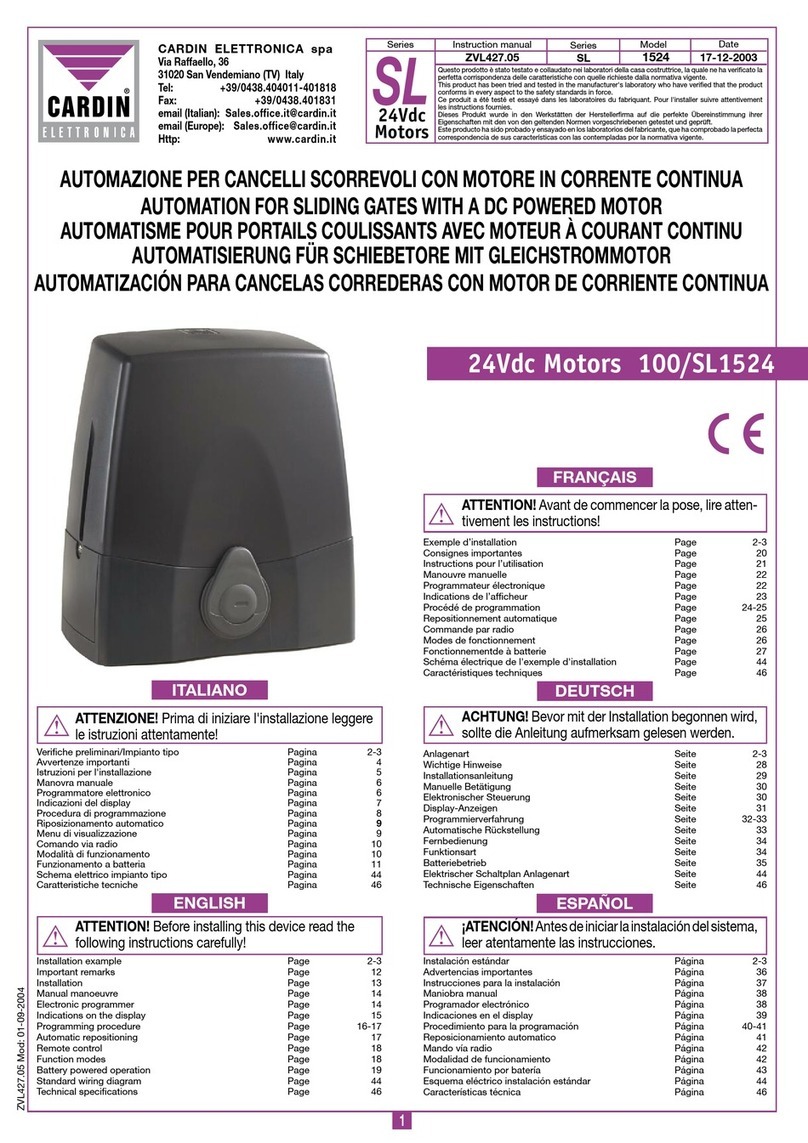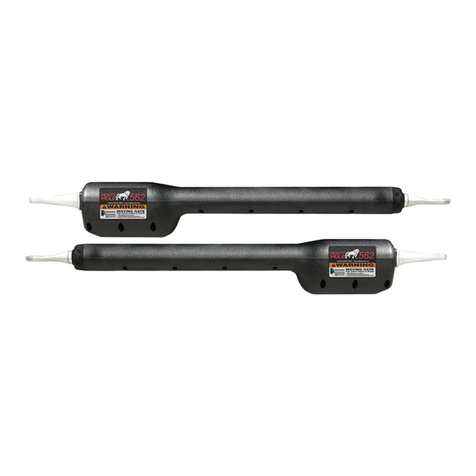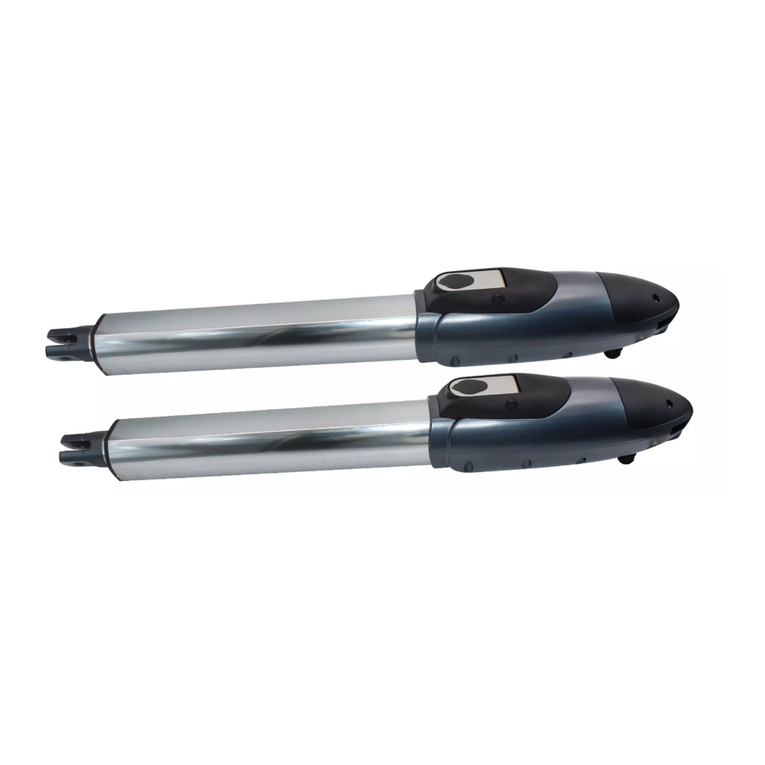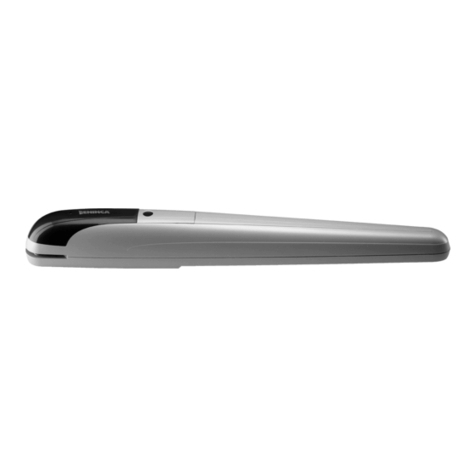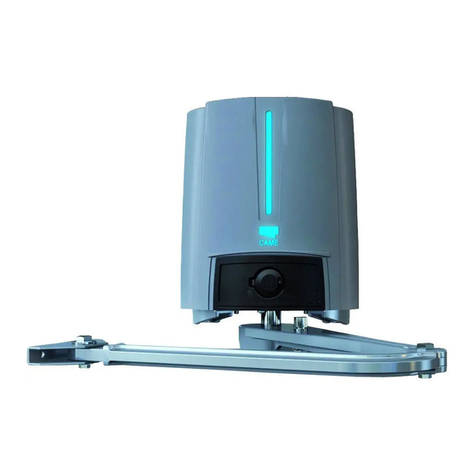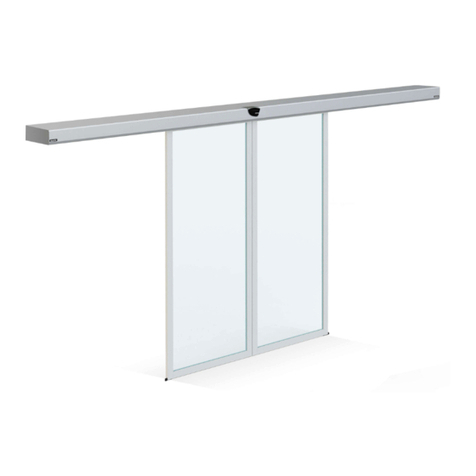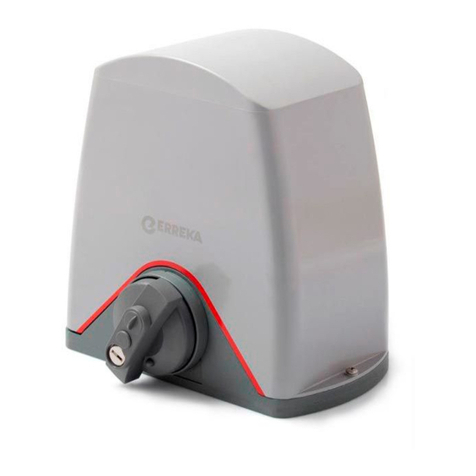Viking R-6S User manual

INSTALLATION
INSTRUCTIONS
AND SAFETY INFORMATION
FOR THE VIKING R-6S GATE OPERATOR
CLASS I
Residential Vehicular
Swing Gate Operator
CLASS I

The R-6S™ Viking Solar Swing Gate Operator is capable of handling
gates up to 700 lbs. and 14 ft. long. With its ef cient drivetrain,
built in solar regulator, VFlex control board and Viking Solar Power
Management Systems; the R-6S™ Gate Operator is the ideal choice
for any solar residential applications.
THE VIKING R-6S™ SWING GATE OPERATOR

VIKING TECHNICAL SUPPORT 1.800.908.0884 1
R-6s Solar Vehicular Gate Operator • Revision SR6MN10.B • May 2015

VIKING TECHNICAL SUPPORT 1.800.908.0884
2
PARTS DIAGRAM:
Item Description Part No.
1 Operator Cover Bolt (4) VASWCB
2 Operator Cover VAR6CO20
3 Output Shaft Knob DWOUK10
4 Output Shaft Cover DWOC20
5 Clutch Key VAWRCK20
6 Clutch and Handle DWCL20
7 Output Arm DWAR20
8 Output Shaft R6OPS20
9 Limit Cam & Holder DWLC10
10 Limit Switch (2) DULS10
11 Limit Switch Holder DWLH10
12 Solar Control Board VSPCB
13 Fuse - 15 amp VNXF15A
14 Fuse - 4 amp VNXF4A
15 Worm Gear #60 Ratio 30:1 R6GB60
16 Alarm DUAL10
17 Solar Terminal Block Assembly VSTBASW
18 Solar Battery Breaker VASBB25
19 Solar Panel Switch DUMRS5
20 Solar Charger VSCHARGSW
21 Motor Switch DUMRS10
22 Power Switch DUMRS10
23 Chassis VSR6CH
24 Sprocket (Gearbox) VASP1034
25 Chain #40x38 Pitches R6CHN40
26 Sprocket (Motor) VASP1058
27 24V DC Gearhead Motor VSR6MO
28 Brush Kit VAMBK
29 Multi-Part Arm Assembly VA-F1ARM20
30 Limit Switch Harness VNXR6LSH

VIKING TECHNICAL SUPPORT 1.800.908.0884 3
OPERATOR REFERENCES:
1.
COVER BOLTS
2.
OUTPUT SHAFT COVER (HAT)
3.
OUTPUT SHAFT KNOB
secures Hat; remove to access manual release
4.
MAIN COVER ASSEMBLY
5.
MANUAL RELEASE HANDLE
releases the clutch to allow for manual operation
6.
CLUTCH KEY
install if application does not require clutch to slip;
remove to manually operate the gate
7.
OUTPUT ARM
connects the Arm Assembly to Clutch & Handle
Assembly
8.
SOLAR CONTROL BOARD
9.
MOTOR SWITCH
discontinues power to the motor; also serves as
a breaker that will self-trip to protect the motor
circuitry
10.
POWER SWITCH
discontinues all power to the control board
11.
SOLAR TERMINAL BLOCK ASSEMBLY
connections for solar panels and battery
12.
SOLAR CHARGER
regulates and distributes solar power

VIKING TECHNICAL SUPPORT 1.800.908.0884
4
CONTROL BOARD REFERENCES:
1.
POWER HARNESS CONNECTOR
provides power to the control board.
pg 20
2.
“OPEN LEFT” & “OPEN RIGHT”
provides power to the motor. pg 21
3.
LIMIT SETUP BUTTONS
available for future developments.
4.
FEATURE ACTIVATION TRIM POTS
activate and set features. pg 24
5.
“EPS1” CONNECTOR
communication for Viking Solar
Charger.
6.
“EPS2” CONNECTOR
available for future developments.
7.
“EMI” CONNECTOR
not applicable to this model.
8.
“CHECK MOTOR” Status LED
indicates motor power status. pg 36
9.
“BATTERY LOW” Status LED
indicates battery power status. pg 36
10.
“POWER” Status LED
control board power status. pg 36
11.
“MAGNETIC LOCK RELAY” Status LED
status of this on-board relay. pg 36
12.
“MAGNETIC LOCK RELAY” Terminal Block
connect electric locks here. pg 36
13.
INPUT STATUS LEDs
indicates input status. pg 36-37
14.
ACCESS CONTROL TERMINAL BLOCKS
accessory connections. pg 29-32, 42-44
15.
“MASTER/SLAVE” Terminal Block
wired master/slave connection. pg 23
16.
CONTROL BOARD MOUNTING HOLES
secures and grounds the control board.
17.
“Siren” TERMINAL BLOCK
Vikings UL Siren is connected here.
18.
ON-BOARD 3 BUTTON STATION
controls the gate during set up.
19.
“AUX. PWR” Terminal Block
used for solar applications & in-motion
warning devices. pg 20, 25
20.
FEATURE ACTIVATION PIN HEADERS
activate features by placing a jumper
onto the pin headers. pg 25
21.
“DIAGNOSE” Button
allows you to navigate through the
Diagnostics LCD Display. pg 38-40
22.
“DIAGNOSE” LED
informs that errors have been detected
and available on LCD Display. pg 38-40
23.
LCD DIAGNOSTICS DISPLAY
provides error messages, diagnostics
and operator status information.
pg 38-40
24.
EXPANSION PRODUCT CONNECTIONS
connections for additional products
from Viking Access Systems. pg 46
25.
“FAIL SAFE/SECURE” Jumper
power failure option. pg 25
26.
FUSE HOLDER - 15 AMP
for motor circuit.
27.
FUSE HOLDER - 4 AMP
not applicable to this model.
28.
HEAT SINK
secures the control board and
dissipates heat.

VIKING TECHNICAL SUPPORT 1.800.908.0884 5
TABLE OF CONTENTS:
PARTS DIAGRAM/PARTS LIST 2
OPERATOR REFERENCES 3
CONTROL BOARD REFERENCES 4
IMPORTANT SAFETY INFORMATION 6-12
Important Safety Instructions 6
Important Installation Instructions 7
Maintenance 8
General Safety Precautions 8-9
Operator Classification 9
Photo Beam (non-contact sensor) Installation 10
Edge Sensor (contact sensor) Installation 11
Manual Release 11
Audible Alarm Reset Installation 12
Warning Placard Installation 12
IMPORTANT INSTALLATION INFORMATION 13
Specifications 13
GATE OPERATOR INSTALLATION 14-17
Concrete Pad Option 14
Post Mounting Option 15
Operator Positioning 16-17
ELECTRICAL INSTALLATION 18-20
Battery & Solar Panel Selection 18
Solar Panel Care & Installation Tips 19
Solar Connection & Power Saving Tips 20
LIMITS SETUP 21-22
MASTER/SLAVE SET UP 23
CONTROL BOARD SETUP 24-26
Initial Settings 24-25
Obstruction Detection Sensor (Primary Entrapment Protection) 26
ACCESSORY CONNECTIONS 29-35
Re-Open Photo Beam (Vehicular Safety) 29
Radio Receiver (Typical) 30
Anti-Tail Gate, Open Commands, Guard Station 31
Viking Loop Rack 32
Guidelines for Loop Installations 33
Blank Page 34
Barrier Arm (B-12) Synchronization Option 35
TROUBLESHOOTING 36-41
LED References 36-37
LCD Display References 38-40
Solutions 41
APPENDIX A & B 42-44
VIKING EXPANSION PRODUCTS 45
PARTS DIAGRAM/PARTS LIST
2
OPERATOR REFERENCES
3
IMPORTANT INSTALLATION INFORMATION
13
GATE OPERATOR INSTALLATION
14-17
ELECTRICAL INSTALLATION 18-20
LIMITS SETUP 21-22
MASTER/SLAVE SET UP
23
CONTROL BOARD REFERENCES
4
IMPORTANT SAFETY INFORMATION
6-12
CONTROL BOARD SETUP 24-26
ACCESSORY CONNECTIONS 29-35
TROUBLESHOOTING
36-41
VIKING EXPANSION PRODUCTS
45
APPENDIX A & B
42-44

VIKING TECHNICAL SUPPORT 1.800.908.0884
6
IMPORTANT SAFETY INFORMATION
!WARNING! Not Following these instructions may cause severe injury or death.
IMPORTANT SAFETY INSTRUCTIONS
!WARNING! To reduce the risk of severe injury or death.
1.
READ AND FOLLOW ALL INSTRUCTIONS.
2.
Never let children operate or play with gate controls. Keep the remote away
from children.
3.
Always keep people and objects away from the gate. NO ONE SHOULD
CROSS THE PATH OF THE MOVING GATE.
4.
Test the gate operator monthly. The gate MUST reverse on contact with
a rigid object or when an object activates the non-contact sensors. After
adjusting the force or the limit travel, retest the gate operator. Failure to
adjust and retest the gate operator properly can increase the risk of injury or
death.
5.
Use the emergency release only when the gate is not moving.
6.
KEEP GATES PROPERLY MAINTAINED. Read the user’s manual. Have a
qualified service person make repairs to gate hardware.
7.
The entrance is for vehicles only. Pedestrians must use a separate entrance.
8.
Every gate operator installation MUST have secondary protection devices
against entrapment, such as edge sensors and photo beams more in
particularly in places where the risk of entrapment is more likely to occur.
9.
SAVE THESE INSTRUCTIONS.
IMPORTANT INSTALLATION INSTRUCTIONS
1.
Install the gate operator only when:
a.
The operator is appropriate for the construction of the gate and usage
Class of the gate (refer to page 9),
b.
All openings of a horizontal slide gate are guarded or screened from the
bottom of the gate to a minimum of 6 feet (1.83 m) above the ground to
prevent a 2-1/4 inch (57.2 mm) diameter sphere from passing through the
openings anywhere in the gate, and in that portion of the adjacent fence
that the gate covers in the open position,
c.
ALL EXPOSED PINCH POINTS ARE ELIMINATED OR GUARDED, AND
d.
GUARDING IS SUPPLIED FOR EXPOSED ROLLERS.
2.
The Operator is intended for installation only on gates used for vehicles.
Pedestrians must be supplied with a separate access opening. The pedestrian
access opening shall be designed to promote pedestrian usage. Locate the
gate such that persons will not come into contact with the vehicular gate
during the entire path of travel of the vehicular gate.
3.
The gate must be installed in a location so that enough clearance is supplied
between the gate and adjacent structures when opening and closing to
reduce the risk of entrapment. Swinging gates shall not open in to the public
access areas.
4.
The gate must be properly installed and work freely in both directions prior to
the installation of the gate operator. Do not over-tighten the operator clutch
or pressure relief valve to compensate for a damaged gate.
5.
The gate operator controls must be placed so that the user has full view of
the gate area when the gate is moving AND AWAY FROM THE GATE PATH
PERIMETER.

VIKING TECHNICAL SUPPORT 1.800.908.0884 7
IMPORTANT SAFETY INFORMATION
!WARNING! Not Following these instructions may cause severe injury or death.
IMPORTANT INSTALLATION INSTRUCTIONS (Continued)
6.
Controls intended for user activation must be located at least six feet (6’)
away from any moving part of the gate and where the user is prevented from
reaching over, under, around or through the gate to operate the controls.
Exception: Emergency access controls only accessible by authorized personnel
(i.e. fire, police, EMS) may be placed at any location in the line-of-sight of the
gate.
7.
The Stop and/or Reset button must be located in the line-of-sight of the gate.
Activation of the reset control shall not cause the operator to start.
8.
A minimum of two (2) WARNING SIGNS shall be installed, one on each side of
the gate where easily visible.
9.
For gate operators using non-contact sensors (Photo Beams or like) in
accordance with section 31.1.1 of the UL standard:
a.
See instructions on the placement of non-contact sensors for each type of
application (refer to page 10).
b.
Care shall be exercised to reduce the risk of nuisance tripping, such as
when a vehicle, trips the sensor while the gate is still moving, and
c.
One or more non-contact sensors shall be located where the risk of
entrapment or obstruction exists, such as the perimeter reachable by a
moving gate or barrier (refer to page 10).
d.
Use only Omron E3K-R10K4 photoelectric eye to comply with UL 325
10.
For a gate operator utilizing a contact sensor (Edge sensor or like) in
accordance with section 31.1.1 of the UL 325 standard:
a.
One or more contact sensors shall be located where the risk of entrapment
or obstruction exists, such as a the leading edge, trailing edge, and post
mounted both inside and outside of a vehicular horizontal slide gate.
b.
One or more contact sensors shall be located at the bottom of a vehicular
vertical lift gate.
c.
One or more contact sensors shall be located at the pinch point of a
vehicular vertical pivot gate.
d.
A hardwired contact sensor shall be located and its wiring arranged so
that the communication between the sensor and the gate operator is not
subject to mechanical damage.
e.
A wireless contact sensor such as one that transmits radio frequency
(RF) signals to the gate operator for entrapment protection functions
shall be located where the transmission of the signals are not obstructed
or impeded by building structures, natural landscaping or similar
obstructions. A wireless contact sensor shall function under the intended
end-use conditions.
f.
One or more contact sensors shall be located on the inside and outside
leading edge of a swing gate. Additionally, if the bottom edge of a swing
gate is greater than 6 inches (152 mm) above the ground at any point in its
arc of travel, one or more contact sensors shall be located at the bottom
edge (refer to page 11).
g.
One or more contact sensors shall be located at the bottom edge of a
vertical barrier (arm).
h.
Only Use Miller Edge Model MGR20 or MGS20 edge sensor to comply with
UL325.

VIKING TECHNICAL SUPPORT 1.800.908.0884
8
IMPORTANT SAFETY INFORMATION
MAINTENANCE
Remove the Power Harness from the Control Board. (refer to page 20)
•Cleanandlubricatetheturningpinsandgatehingesusingtherecommended
lubricant.
•Checkthatallhardwareofthegateoperatorisproperlytighten.
•Ensurethatthegatemovesfreely.
•Checkforcorrodedpartsandreplaceifnecessary.
•Checkthebatteryforthefollowing:
- Battery connections must be free of corrosion.
- Battery voltage must be 13VDC (fully charged battery).
Reconnect the Power Harness for the Control Board. (refer to page 20)
•Checkandconfirmtheproperoperationofallsafetydevices(photoelectric
eye, edge sensors or like).
•Checkandconfirmtheoperationofallinstalledaccessories.
•CheckandconfirmtheoperationofallspecialfeaturessuchastheIntelligent
Obstruction Sensor, Hold Open Timer. (refer to page 24 and 26)
•Checkandconfirmtheoperationofthemanualrelease.(refertopage7)
GENERAL SAFETY PRECAUTIONS
The following precautions are an integral and essential part of the product and must be
supplied to the user. Read them carefully as they contain important indications for the
safe installation, use and maintenance.
•Theseinstructionmustbekeptandforwardedtoallpossiblefutureusersofthe
system.
•Thisproductmustbeusedonlyforthatwhichithasbeenexpresslydesigned.
•Anyotheruseistobeconsideredimproperandthereforedangerous.
•Themanufacturercannotbeheldresponsibleforpossibledamagecausedby
improper, erroneous or unreasonable use.
•Avoidoperatingintheproximityofthehingesormovingmechanicalparts.
•Donotenterthepathofthemovinggatewhileinmotion.
•Donotobstructthemotionofthegateasthismaycauseasituationofdanger.
•Donotallowchildrentoplayorstaywithinthepathofthemovinggate.
•Keepremotecontroloranyothercontroldevicesoutofthereachofchildren,in
order to avoid possible involuntary activation of the gate operator.
•Incaseofbreakdownormalfunctioningoftheproduct,disconnectfromthemain
power source. Do not attempt to repair or intervene directly, contact only qualified
personnel for repair.
•Failuretocomplywiththeabovemaycreateasituationofdanger.
•Allcleaning,maintenanceorrepairworkmustbecarriedoutbyqualifiedpersonnel.
•Inordertoguaranteethatthesystemworksefficientlyandcorrectlyitisimportant
to have the manufacturer’s instructions on maintenance of the gate and operator
carried out by qualified personnel.
•Inparticular,regularchecksarerecommendedinordertoverifythatthesafety
devices are operating correctly.
All installation, maintenance and repair work must be documented and made
available to the user.
!WARNING! Not Following these instructions may cause severe injury or death.

VIKING TECHNICAL SUPPORT 1.800.908.0884 9
! CAUTION: To Reduce the Risk of Fire or Injury to Persons:
IMPORTANT SAFETY INFORMATION
Install the gate operator only when:
The operator is appropriate for the construction of the gate and the Usage Class of
the gate.
UL325 Gate Operator Classifications
GLOSSARY
RESIDENTIAL VEHICULAR GATE OPERATOR
CLASS I - A vehicular gate operator (or system) intended
for use in garages or parking areas associated with a
residence of one-to four single families.
COMMERCIAL/GENERAL ACCESS VEHICULAR GATE OPERATOR
CLASS II – A vehicular gate operator (or system)
intended for use in a commercial location or building
such as a multi-family housing unit (five or more single
family units), hotel, garages, retail store, or other
building servicing the general public.
INDUSTRIAL/LIMITED ACCESS VEHICULAR GATE OPERATOR
CLASS III – A vehicular gate operator (or system)
intended for use in an industrial location or building
such as a factory or loading dock area or other
locations not accessible by or intended to service the
general public.
RESTRICTED ACCESS VEHICULAR GATE OPERATOR
CLASS IV – A vehicular gate operator (or system)
intended for use in a guarded industrial location or
building such as an airport security area or other
restricted access locations not servicing the general
public, in which unauthorized access is prevented via
supervision by security personnel.

VIKING TECHNICAL SUPPORT 1.800.908.0884
10
IMPORTANT SAFETY INFORMATION
NOTE: This type on installation DOES NOT reverse the gate all the way back to
its limits when the photo beam is obstructed. This installation is only to protect
against entrapment and to comply with UL325.
Secondary Entrapment Protection
Photo Beam (non-contact sensor) Installation
•
Photo beams or like must be installed to reduce the risk of entrapment.
•
Use only Omron E3K-R10K4 photoelectric eye to comply with UL325
•
Make the electrical connections of the photoelectric sensor as described here in
this page.
•
Care shall be exercised to reduce the risk of nuisance tripping, such as when a
vehicle, trips the sensor while the gate is still moving, and;
•
One or more non-contact sensors shall be located where the risk of entrapment or
obstruction exists, such as the perimeter reachable by a moving gate or barrier.
Consult the installation manual for the UL325 device (photo beam or like) for detail
information about the usage, installation and maintenance.
!WARNING! Not Following these instructions may cause severe injury or death.

VIKING TECHNICAL SUPPORT 1.800.908.0884 11
NOTE: This type on installation DOES NOT reverse the gate all the way back to
its limits when the edge sensor is obstructed. This installation is only to protect
against entrapment and to comply with UL325.
Secondary Entrapment Protection
Edge Sensor (contact sensor) Installation
•
Edge Sensors or like must be installed to reduce the risk of entrapment.
•
Use only Miller Edge 3-sided activation type MGR20 or MGS20 to comply with
UL325
•
One or more contact sensors shall be located on the inside and outside leading
edge of a swing gate. Additionally, if the bottom edge of a swing gate is greater
than 6 inches (152 mm) above the ground at any point in its arc of travel, one or
more contact sensors shall be located on the bottom edge.
1.
A hardwired contact sensor shall be located and its wiring arranged so that the
communication between the sensor and the gate operator is not subjected to
mechanical damage.
2.
A wireless contact sensor such as one that transmits radio frequency (RF)
signals to the gate operator for entrapment protection functions shall be located
where the transmission of the signals are not obstructed or impeded by building
structures, natural landscaping or similar obstruction. A wireless contact sensor
shall function under the intended end-use conditions.
IMPORTANT SAFETY INFORMATION
Manual Release
When manual operation is required:
1.
Remove the “Output Shaft Cover” or Hat.
2.
Lift the “Manual Release Handle”.
3.
Remove the “Clutch Key”.
To resume normal operation:
1.
Align the notches on the Output Shaft to
the clutch and reinstall the Clutch Key.
2.
Push the Manual Release Handle down,
back to the locked position.
Refer to page 17 for more details
!WARNING! Not Following these instructions may cause severe injury or death.

VIKING TECHNICAL SUPPORT 1.800.908.0884
12
Audible Alarm Reset Switch Installation
Manual Reset for the Audible Alarm
•
UL325 standard requires an audible alarm sound off after two consecutive events
detected by the primary entrapment protection of the gate operator (obstruction
sensor).
•
The audible alarm will continue to sound for 5 minutes or until a stop command
gets actuated.
•
The Stop command can be actuated in two different forms:
1.
Using the Built in Stop switch on the Control Board or;
2.
Using an External Stop button within the sight of the gate, away from moving
parts of the gate and out of reach of children.
a.
Controls intended for user activation must be located at least six feet (6’)
away from any moving part of the gate and where the user is prevented from
reaching over, under, around or through the gate to operate the controls.
Outdoor or easily accessible controls shall have a security feature to prevent
unauthorized use.
b.
The Stop and/or Reset button must be located in the line-of-sight of the gate.
Activation of the reset control shall not cause the operator to start.
IMPORTANT SAFETY INFORMATION
!WARNING! Not Following these instructions may cause severe injury or death.
Warning Placard Installation
•
All Warning Placards must be installed
where visible in the area of the gate.
•
A minimum of two placards shall be in-
stalled.
•
A placard is to be installed in the area of
each side of the gate and be visible.
2

VIKING TECHNICAL SUPPORT 1.800.908.0884 13
! CAUTION: To Reduce the Risk of Fire or Injury to Persons:
! WARNING: For use with gates at a maximum 700 lbs. in weight and 14 ft. in length.
IMPORTANT INSTALLATION INFORMATION
Locate Control Buttons:
1.
Within sight of the gate,
2.
At a minimum height of 5 feet
so small children are not able to
reach it; and
3.
At least 6 feet away from all
moving parts of the gate.
DO NOT allow pedestrian use of this gate DO NOT install the gate operator to lift gates
14 ft. 700 lb.
R-6SSpecications:
UL Application Class: Class I
Maximum Gate Length: 14 ft.
Maximum Gate Weight: 700 lb.
Operating Temperature: -4°F (-20°C) to 160°F (71°C)

VIKING TECHNICAL SUPPORT 1.800.908.0884
14
GATE OPERATOR INSTALLATION
Concrete Pad Option
1.
Follow the local building code to determine the required depth of the
concrete pad.
2.
Pad measurements recommended by Viking Access Systems are at least
23” long, 20” wide and 30” deep to ensure the stable operation of the
operator, and a minimum of 6” above level grade to avoid any flooding of
the machinery.
3.
Provide a sufficient number of conduit pathways for all low power
accessories such as loop detector leads, maglock, non-contact sensors,
contact sensors, safety and other commands. Also provide conduit for the
power supply to the operator.
!DO NOT run low voltage and high voltage wiring in the same conduit.
!Provide at least 12” separation between low and high voltage conduits.

VIKING TECHNICAL SUPPORT 1.800.908.0884 15
Post Mounting Option
TIP: The operator can be post mounted to be elevated above snow and flood lines.
1.
Consult the local building codes for the depth and concrete requirements.
2.
Maximum 3.00” OD pipe.
3.
Provide a sufficient number of conduit pathways for all low power accessories.
Also provide conduit for the power supply to the operator.
!DO NOT run low voltage and high voltage wiring in the same conduit.
!Provide at least 12” separation between low and high voltage conduits.
GATE OPERATOR INSTALLATION
REQUIRED ADD-ON: PART# VA-F1PS
•
Main pieces made of 1/4” thick material
•
All mounting hardware is included
•
Posts and U-Bolts are not supplied

VIKING TECHNICAL SUPPORT 1.800.908.0884
16
Operator Positioning
!IM PORTANT: Swing Gates must not open into public access areas.
The gate must be installed in a location so that enough clearance is supplied between the
gate, while opening and closing, and adjacent structures to reduce the risk of entrapment.
GATE OPERATOR INSTALLATION
!TECHNICAL TIPS: Operator and Arm Geometry
•
Increasing “C” dimension provides better gate control and stability by reducing the
affects of inertia and deceasing the gate leverage against the operator.
•
Following to the geometrical formulas and relationships provided is recommended.
Arm Assembly: VA-F1ARM20

VIKING TECHNICAL SUPPORT 1.800.908.0884 17
GATE OPERATOR INSTALLATION
STEP 1
Install the Clutch and cut the
Arm Assembly to achieve
the desired dimensions for
“D” and “E” according to the
formulas provided on page 16.
STEP 2
With the gate at the closed,
install the Arm Assembly.
Check that the dimensions
correspond accordingly to the
formulas provided on page 16.
!IM PORTANT: When attaching the Arm Assembly to the gate, if the “Gate Bracket” is not
welded to a frame member that runs the full length of the gate, the operator may damage
the gate. Do not attach the Gate Bracket to only a few pickets.
!TIP: Leave some additional material
when cutting the Arm Assembly to
allow for adjustment.
!TIP: Use C-clamps or tack-weld the Arm
assembly in place until Step 3 has been
completed.
STEP 3
With the Clutch installed and released,
manually move the gate to both limits.
Verify the following:
1.
The gate reaches the desired limits.
2.
The Arm does not bind at any point.
STEP 4
Once satisfied with the installation and
movement of the gate, weld the arm
pieces securely. Paint the Arm to protect
against rusting.
STEP 5
Rotate the Clutch until it lines up with the
notches on top of the Output Shaft and
insert the Clutch Key.
STEP 6
Verify the Clutch is adjusted properly.
•
Both sides adjusted evenly.
•
Handle is locked, by hand, and
positioned horizontally at 0°.
With the Clutch Key removed, the
Clutch should not slip with moderate
force applied to the gate.

VIKING TECHNICAL SUPPORT 1.800.908.0884
18
Battery
Storage
ELECTRICAL INSTALLATION
Battery Selection
•
Battery is sold separately.
•
Use only UL recognized 12V Sealed Lead Acid (SLA)
•
35Ah Maximum battery capacity.
Battery Care and Location
•
Use at least 12AWG wire, rated 90°C or better.
•
A 35Ah battery can be stored under the chassis of
the operator, behind the control board.
•
Ensure the battery terminals will maintain a 1/4”
spacing from all other circuits and metal parts.
•
Donotdisposeofthebatteryinre.Thecellsmayexplode.
Check with local codes for possible disposal instructions.
•
Do not open or mutilate the battery. Released electrolyte
is corrosive and may cause damage to the eyes or skin. It
may be toxic if swallowed.
•
Exercise care in handling batteries in order not to short the
battery with conducting materials such as rings, bracelets
and keys.
•
CAUTION - A battery can present a risk of electrical shock,
burnfromhighshortcircuitcurrent,reorexplosionfrom
vented gasses. Observe proper precautions.
•
Observe proper polarity orientation between the battery
and charging circuit.
Solar Panel Selection
•
Solar panel(s) are sold separately.
•
Use only UL Listed 12V solar panel(s), such as Viking part #s:
Wattage Viking Part# Open-Circuit
Voltage
Short-Circuit
Current
20 Watts VA-SO20W 21.7V 1.25A
40 Watts VA-SO40W 21.8V 2.57A
! Important: The number of cycles achieved daily is dependent on many factors,
including current draw of the motor and accessories, and local solar radiation data.
If more specific information is needed please consult with Viking Access Systems.
For more information regarding solar energy refer to: http://rredc.nrel.gov/solar/
pubs/redbook/
Ratings
System Voltage: 12V
Max. Solar Wattage: 40W
Max. Solar Voltage: 29V
Max. Battery Capacity: 35Ah
Min. Battery Voltage: 8V
Max. Charger Load Current: 3A
Output Voltage for Controls: 24V This is the voltage the control board will provide
SAVE THESE INSTRUCTIONS - This manual contains important instructions for the
R-6s model gate operator that shall be followed during installation and maintenance
of the charge controller.
Table of contents
Other Viking Gate Opener manuals
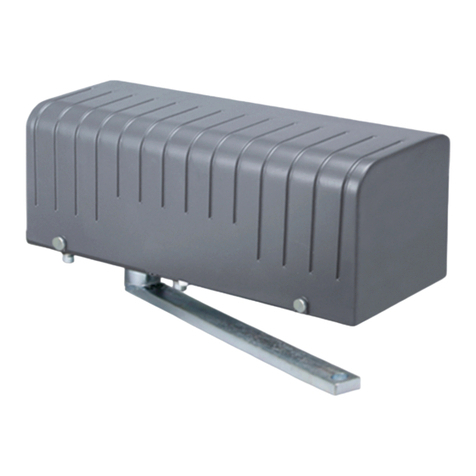
Viking
Viking X-9 Original instructions

Viking
Viking Q-4 User manual
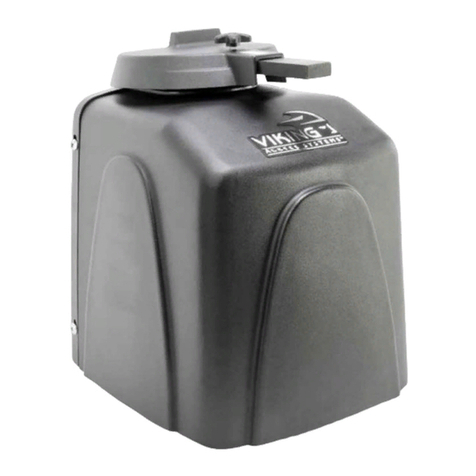
Viking
Viking R-6 Original instructions
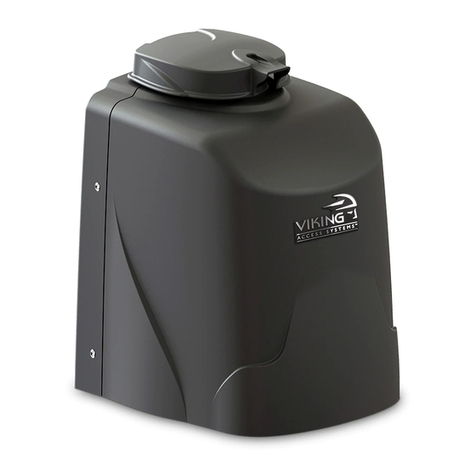
Viking
Viking F-1 User manual

Viking
Viking G-5 User manual

Viking
Viking R-6 Product information sheet

Viking
Viking X-390 User manual
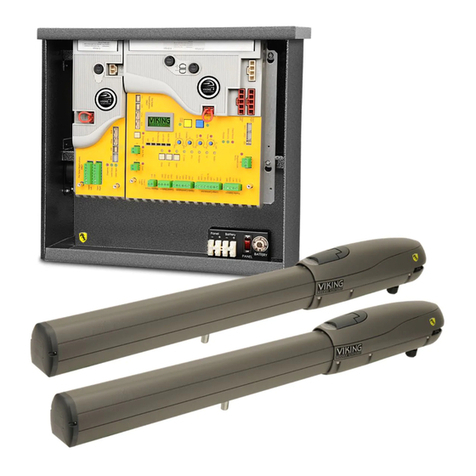
Viking
Viking G-5S User manual
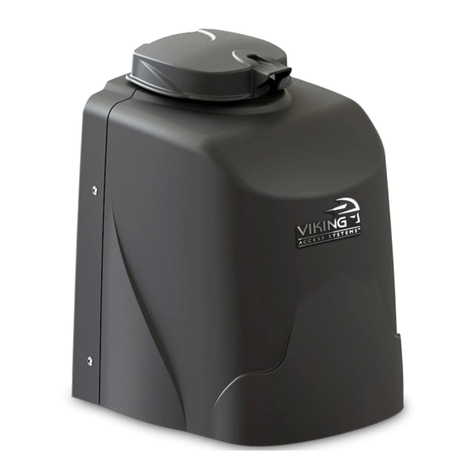
Viking
Viking F-1NX Original instructions

Viking
Viking T-21 Original instructions
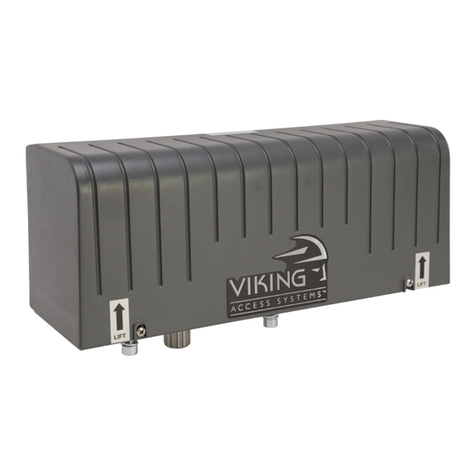
Viking
Viking X-9S Original instructions

Viking
Viking I-770 Original instructions
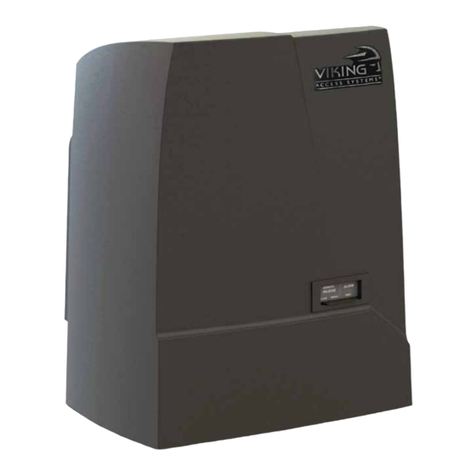
Viking
Viking Designer I User manual
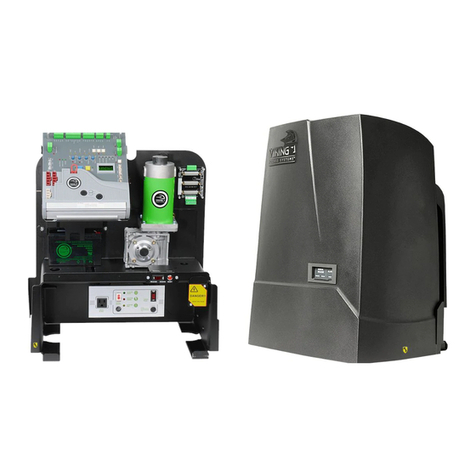
Viking
Viking L-3 User manual

Viking
Viking F-1 User manual
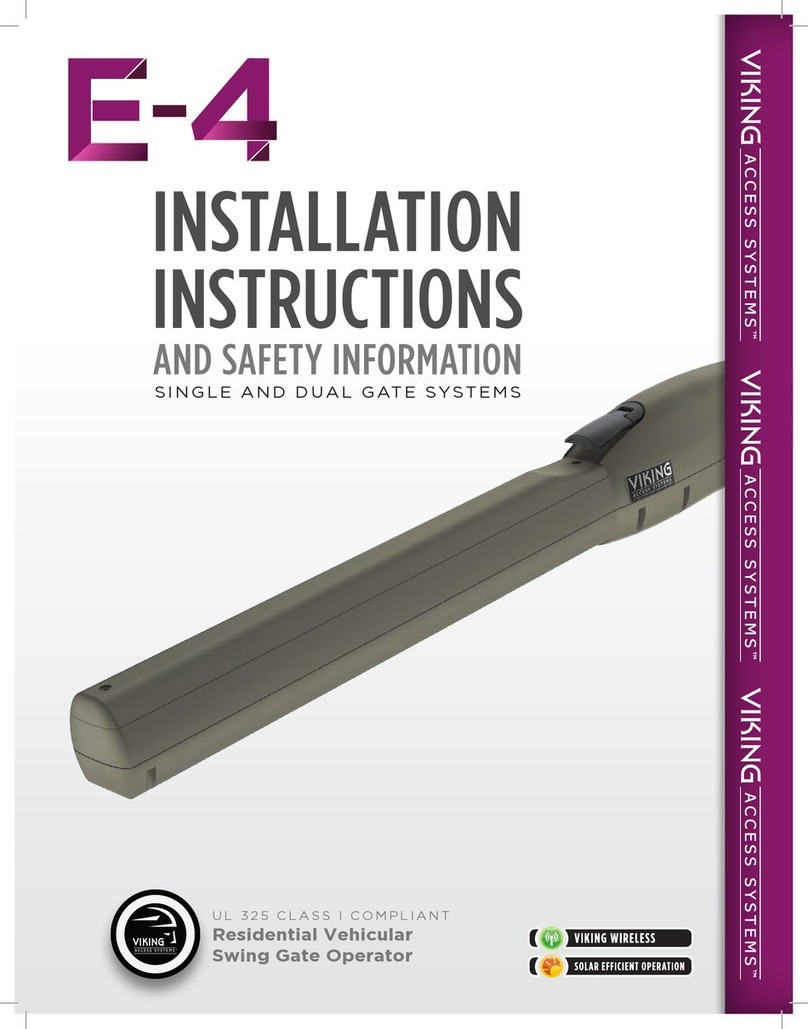
Viking
Viking E-4 User manual
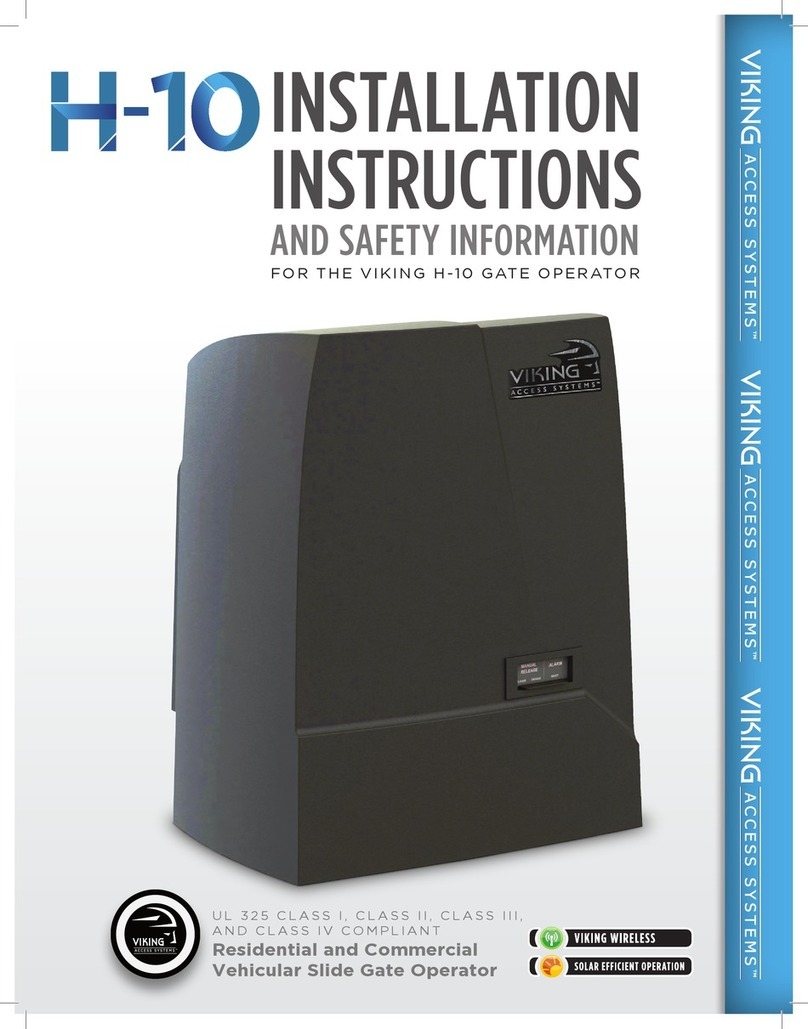
Viking
Viking H-10 Original instructions

Viking
Viking G-5 Original instructions
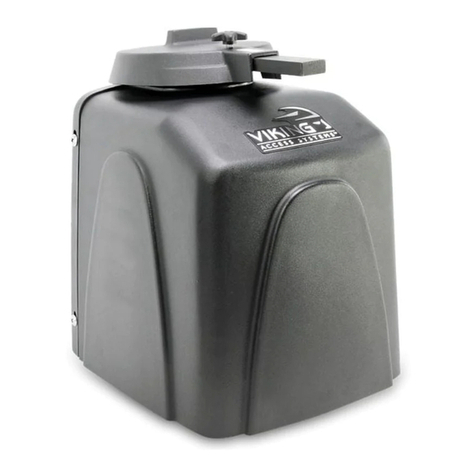
Viking
Viking R-6NX Original instructions
